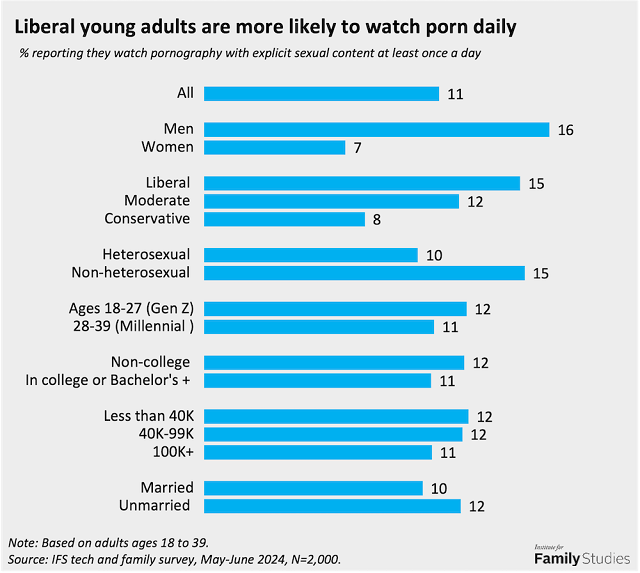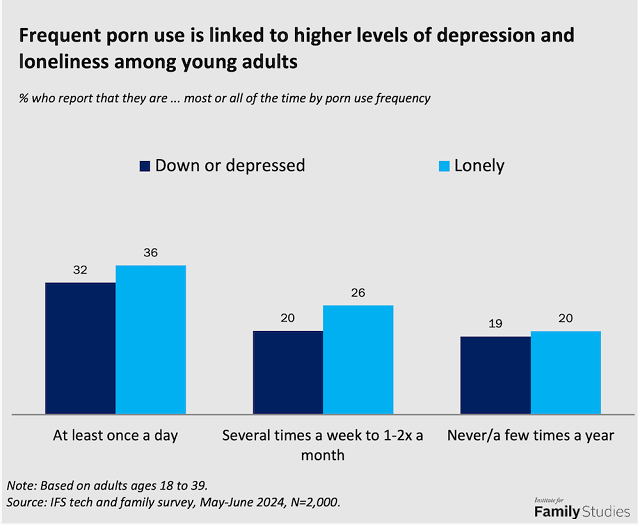Highlights
- A new Institute for Family Studies/YouGov survey finds that pornography has become a daily part of life for many young adults. Post This
- Regular porn use is much more prevalent among young adults who lean left politically. Post This
- Nearly 1 in 3 young adults (32%) who watch pornography at least once a day report feeling “down, depressed, or hopeless” most or all of the time, compared with 19% of those who rarely or never watch it. Post This
A swathe of laws in states across the country have been adopted to require that individuals who wish to access pornography sites provide verification of age. These laws are premised upon the fact that pornography is inappropriate for children and profoundly harmful to the mental health of users, especially with frequent use.
The former claim is not a matter of controversy. But what about the latter claim—that porn use is damaging to the mental health of many impressionable young Americans?
This question is critical—not only regarding the validity of these laws—but because online pornography has become much more prevalent today with easy access provided by smart phones. In fact, porn is now a dominant form of internet and social media content, available to anyone, regardless of age. Young adults tend to be the most active pornography users, with the average age of first exposure being as young as 12, including many children that happen upon it at 10 years old or even younger.
Additionally, the content of pornography has worsened over the years. As many have remarked, the porn that Americans regularly consume is not “your daddy’s Playboy” but is increasingly graphic, violent, and extreme. One study found that 88% of scenes in popular pornography videos involved physical aggression and 49% contained verbal aggression. An investigation by New York Times journalist Nicholas Kristoff into Pornhub, one of the world’s largest providers of internet pornography, exposes serious issues on the platform, including videos of rape and child sexual abuse.
In light of these issues, it is important to consider the potential effects of pornography on Americans as they transition from adolescence to young adulthood, and to examine who is using porn most frequently.
The Demographics of Daily Porn Use
In a new Institute for Family Studies/YouGov survey of 2,000 adults under age 40, we found that pornography has become a daily part of life for many young adults. This survey defines porn as “pornography with explicit sexual content.” About 1-in-10 Gen Z (ages 18-27) and younger Millennials (ages 28 to 39) report watching porn online at least once a day. This is a narrower definition and time frame than other measures used in previous studies, which looked at “most recent use.”1
According to the IFS survey, men are about twice as likely as women to report being daily users of online pornography (16% vs. 7%). This large gender gap is consistent with previous research findings on pornography use patterns.
On the other hand, regular porn use is much more prevalent among young adults who lean left politically. Liberal young adults are about twice as likely as those who are conservative to report watching online pornography at least once daily (15% vs. 8%). This ideology gap is nearly as large as the gender gap.

Moreover, sexual orientation is a meaningful factor related to frequent pornography use, with heterosexual young adults less likely than non-heterosexual young adults to be frequent users. About 10% of heterosexual young adults report watching online porn at least once a day, compared with 15% of non-heterosexual young adults.2
At the same time, frequent use of pornography among young adults does not vary significantly by many standard demographic factors, such as age, education, or income. Among American adults under age 40, about the same share of Gen Z (ages 18 to 27) and Millennials (ages 28-39) use pornography daily. The differences are small or non-existent among adults across family income levels, education, race, religious attendance, and even marital status.
Frequent Porn Use, Depression, and Loneliness
Frequent use of online pornography is linked to an increased occurrence of negative mental health outcomes among young adults. Nearly 1 in 3 young adults (32%) who watch pornography at least once a day report feeling “down, depressed, or hopeless” most or all of the time, compared with 19% of those who rarely or never watch porn.

Young adults who watch pornography on a daily basis are also more likely to experience loneliness. More than 1 in 3 young adults who watch pornography daily (36%) report feeling lonely most or all of the time, compared with 20% of young adults who rarely or never watch it.
Moreover, the link between frequent pornography use and young adults’ emotional well-being remains significant even after we control for factors such as gender, race/ethnicity, sexual orientation, marital status, income, and education. Specifically, watching pornography at least once a day doubles the risk of being depressed and increases the risk of feeling lonely by a similar amount.
Our findings are consistent with previous studies that show that excessive use of pornography is associated with negative mental health outcomes such as depression and anxiety. Moreover, frequent use of pornography may displace activities that contribute to healthy social relationships, leaving users feeling more lonely and depressed.
It is important to recognize the addictive nature of online pornography, which many young adults may not realize. Studies indicate that frequent porn use can affect the brain's reward system, leading to desensitization and an increased need for more extreme content to achieve the same level of stimulation, similar to drug addiction. Moreover, pornography sites use similar techniques as social media platforms, such as infinite scroll, autoplay, and personalized content, to keep users engaged. Like social media companies, rapt attachment is central to the business model of online pornography providers.
A Public Health Hazard
Considering these findings, addressing the mental health risks associated with frequent pornography use, particularly its link to depression and loneliness, should be a priority for health professionals and American policymakers. Amid America’s ongoing mental health crisis, especially among young adults, it is crucial to understand and mitigate the addictive nature of online pornography. Widespread use of porn has the potential to negatively affect individual well-being as well as social relationships and overall community health.
Wendy Wang (@WendyRWang on X) is director of research at the Institute for Family Studies. Michael Toscano is executive director of the Institute for Family Studies.
1. For example, a 2014 survey found a much larger prevalence of use by polling respondents’ most recent use: “46% of men and 16% of women between the ages of 18 and 39 intentionally viewed pornography in a given week.”
2. Our online survey of young adults under age 40 finds that about 28% of Gen-Z and 19% of younger Millennials identify as non-heterosexual. This group includes those who identify as LGBTQ as well as young adults who are uncertain about their sexual orientation.












